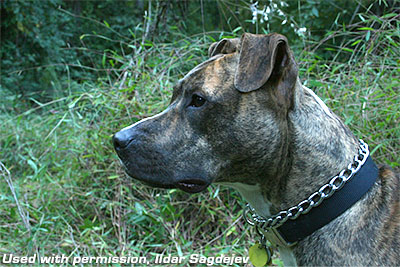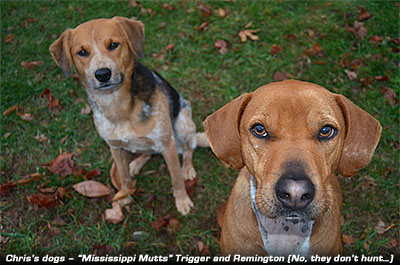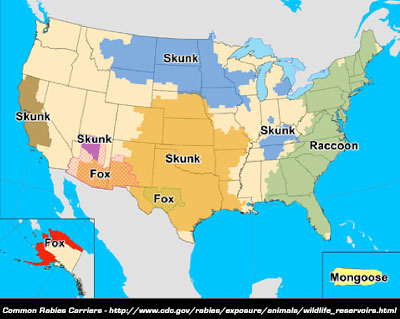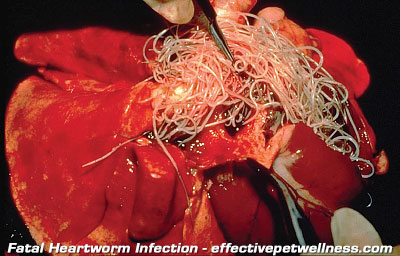Chris Magee, DVM is on deployment in the desert, and still joins us this week with some great advice on some things you can do to protect your beloved hunting dog. Who wants to invest in a great dog only to have it’s hunting days or life cut short?
Here’s Chris:
 When some hunters enter the woods, they pack more than just a good rifle—they take a pack of highly-trained hunting dogs. Catahoulas, Pit Bulls, Rhodesian Ridgebacks, Curs, and sometimes even good ole “Mississippi Mutts” are always anxious to track down a group of wild hogs. There is no secret about the dangers these pups face when they go head-to-head with an angry boar. While it may be near impossible to find a veterinarian that is excited about sending dogs into that situation, we would always encourage taking every safety precaution possible.
When some hunters enter the woods, they pack more than just a good rifle—they take a pack of highly-trained hunting dogs. Catahoulas, Pit Bulls, Rhodesian Ridgebacks, Curs, and sometimes even good ole “Mississippi Mutts” are always anxious to track down a group of wild hogs. There is no secret about the dangers these pups face when they go head-to-head with an angry boar. While it may be near impossible to find a veterinarian that is excited about sending dogs into that situation, we would always encourage taking every safety precaution possible.
Most hunters are aware of the GPS tracking collars and protective vests that are widely available today, and I highly encourage using these tools. Concerning the vest, it is important to ensure your dog has normal mobility, vital areas are well protected, and proper measures are taken to avoid overheating. That brings us to a list of often overlooked aspects of your hunting dogs’ health and safety:
 OVERHEATING: Hog hunting often occurs in warmer parts of the year, especially in the southern US. A heat injury can occur in any breed; however, it is more common in the short-nosed, flat-faced breeds. The normal dog’s body temperature range is about 100.5-102.5°F, but a hunting dog may have a temperature slightly higher than this during and after a hard day’s work. It’s a good idea to know your dog’s normal working temperature (an inexpensive digital thermometer gently placed rectally does the trick). Check your dog’s temperature after each hunt. If it’s higher than normal or you notice any of the following signs–excessive panting, increased drooling, dark/reddened gums, rapid heart rate, difficulty breathing, depression, lethargy, or seizures—your dog may be suffering from a heat injury, and it is critical to get to the nearest veterinary clinic immediately. If you have a water source nearby, spraying your dog with cool water (not ice water) can greatly help decrease body temperature. Do not cover your dog with wet towels as this can actually act like insulation. Having a spray bottle of isopropyl alcohol can also help. Spray your dog’s footpads, groin area, and armpits with the alcohol while on your way to the veterinary clinic, and make sure you have the A/C on full blast. Temperatures over 106°F can be deadly—leading to organ failure, bleeding disorders, seizures, and ultimately cardiopulmonary arrest. Don’t waste any time getting to a veterinarian, and begin working to cool your dog as soon as possible. He will require close monitoring at your veterinarian’s office while he recovers. In order to prevent heat injuries, do not hunt on extremely hot and humid days, and never leave them unattended in your vehicle. It is also important to make sure that your dogs are well acclimated to the seasonal temperatures before being put to work. And of course, fresh water should be readily available before and after the hunt. Don’t rely on natural bodies of water to keep your dog hydrated, which leads us into our next topic.
OVERHEATING: Hog hunting often occurs in warmer parts of the year, especially in the southern US. A heat injury can occur in any breed; however, it is more common in the short-nosed, flat-faced breeds. The normal dog’s body temperature range is about 100.5-102.5°F, but a hunting dog may have a temperature slightly higher than this during and after a hard day’s work. It’s a good idea to know your dog’s normal working temperature (an inexpensive digital thermometer gently placed rectally does the trick). Check your dog’s temperature after each hunt. If it’s higher than normal or you notice any of the following signs–excessive panting, increased drooling, dark/reddened gums, rapid heart rate, difficulty breathing, depression, lethargy, or seizures—your dog may be suffering from a heat injury, and it is critical to get to the nearest veterinary clinic immediately. If you have a water source nearby, spraying your dog with cool water (not ice water) can greatly help decrease body temperature. Do not cover your dog with wet towels as this can actually act like insulation. Having a spray bottle of isopropyl alcohol can also help. Spray your dog’s footpads, groin area, and armpits with the alcohol while on your way to the veterinary clinic, and make sure you have the A/C on full blast. Temperatures over 106°F can be deadly—leading to organ failure, bleeding disorders, seizures, and ultimately cardiopulmonary arrest. Don’t waste any time getting to a veterinarian, and begin working to cool your dog as soon as possible. He will require close monitoring at your veterinarian’s office while he recovers. In order to prevent heat injuries, do not hunt on extremely hot and humid days, and never leave them unattended in your vehicle. It is also important to make sure that your dogs are well acclimated to the seasonal temperatures before being put to work. And of course, fresh water should be readily available before and after the hunt. Don’t rely on natural bodies of water to keep your dog hydrated, which leads us into our next topic.
LEPTOSPIROSIS: Leptospirosis, or “lepto” as it’s commonly called, is a bacterial infection that can cause severe kidney and liver disease. The kicker on this one—it’s zoonotic—meaning you can also get this disease from an infected dog or other animal. Multiple species of wildlife and livestock harbor this bacterium, and it’s commonly shed in their urine. Dogs may become infected by drinking from small bodies of water or streams frequented by infected animals, or by direct contact with bodily fluids from an infected animal. A vaccine is available, and I highly recommend it for all outdoor dogs. Unfortunately, the vaccine only covers some of the possible strains that are out there, but some protection is better than no protection at all. So get your dogs vaccinated, and you should probably avoid drinking from lakes and streams yourself. See the CDC website for more information: http://www.cdc.gov/leptospirosis/pets/index.html.
 RABIES VIRUS: As the only vaccine regulated by law in most states, it is critical that your dogs be properly vaccinated for rabies. Rabies is considered 100% fatal to dogs, cats, and any other mammal that becomes infected—including humans (yes, this one is zoonotic too). There is no cure or treatment once the disease takes hold. Foxes, raccoons, skunks, and bats are common reservoirs for the virus, but many other mammals can carry the disease, too. Transmission occurs through the saliva of an infected animal. If an unvaccinated dog is bitten by a potential rabies carrier (hogs included), they will face euthanasia or extremely long, strict quarantines to ensure they did not actually contract the disease. This is a no-brainer–vaccinate your pets and make sure the vaccine remains current. See your veterinarian to make sure your dogs and other pets are up to date on their rabies vaccines. Otherwise, you not only endanger your dog, but you endanger yourself and anyone your dog may come in contact with.
RABIES VIRUS: As the only vaccine regulated by law in most states, it is critical that your dogs be properly vaccinated for rabies. Rabies is considered 100% fatal to dogs, cats, and any other mammal that becomes infected—including humans (yes, this one is zoonotic too). There is no cure or treatment once the disease takes hold. Foxes, raccoons, skunks, and bats are common reservoirs for the virus, but many other mammals can carry the disease, too. Transmission occurs through the saliva of an infected animal. If an unvaccinated dog is bitten by a potential rabies carrier (hogs included), they will face euthanasia or extremely long, strict quarantines to ensure they did not actually contract the disease. This is a no-brainer–vaccinate your pets and make sure the vaccine remains current. See your veterinarian to make sure your dogs and other pets are up to date on their rabies vaccines. Otherwise, you not only endanger your dog, but you endanger yourself and anyone your dog may come in contact with.
Common Rabies Carriers – http://www.cdc.gov/rabies/exposure/animals/wildlife_reservoirs.html
VENOMOUS SNAKES: Every hog hunter knows the snakes to watch out for in the woods, but does your dog? Venomous snakes are all over the country, and curious pups all too often find themselves nose-to-nose with these creatures. Check with your local dog-training facilities—many offer classes on snake avoidance. This training will be invaluable for any hunting dog. Snake bites are an emergency that can quickly advance to shock, bleeding disorders, organ failure, and death. If your dog is bitten, minimize any physical exertion, and get him to a veterinarian as quickly as possible. Applying a tourniquet and/or suctioning the wound are not effective first-aid measures and should not be used. If you’re in rattlesnake country (aren’t we all?), talk to your veterinarian about the rattlesnake vaccine—it might be worth a “shot.”
 HEARTWORM DISEASE: Heartworms are present throughout the US, but they are an especially prevalent threat in the Southeast and along the Mississippi River Valley. Carried by a mosquito, these parasites enter into the dog’s body as tiny larvae and develop into 6-12 inch worms that wreak havoc on the heart and lungs. We all know the joys of fighting mosquitoes during those evening hog hunts. Thankfully, humans are resistant to heartworm infection. Your dogs aren’t so lucky. Prevention is easy—a monthly tablet or a 6-month injection that you can get from your veterinarian. Your dog must remain on this preventative for its entire life. Once an infection sets up, the damage is permanent and the treatment is extremely expensive and time consuming. A severe case of heartworm disease is often fatal. Protect your dogs from this parasite—see your veterinarian for more information.
HEARTWORM DISEASE: Heartworms are present throughout the US, but they are an especially prevalent threat in the Southeast and along the Mississippi River Valley. Carried by a mosquito, these parasites enter into the dog’s body as tiny larvae and develop into 6-12 inch worms that wreak havoc on the heart and lungs. We all know the joys of fighting mosquitoes during those evening hog hunts. Thankfully, humans are resistant to heartworm infection. Your dogs aren’t so lucky. Prevention is easy—a monthly tablet or a 6-month injection that you can get from your veterinarian. Your dog must remain on this preventative for its entire life. Once an infection sets up, the damage is permanent and the treatment is extremely expensive and time consuming. A severe case of heartworm disease is often fatal. Protect your dogs from this parasite—see your veterinarian for more information.
Fatal Heartworm Infection – effectivepetwellness.com
TICKS & FLEAS: Ticks carry many diseases that can be spread to your dog such as ehrlichiosis, Lyme disease, anaplasmosis, babesiosis, Rocky Mountain spotted fever, and others. Fleas can spread tapeworms and cause flea allergy dermatitis. Fleas also carry plague! Dogs are relatively resistant to that disease, but a plague-carrying flea could still hitch a ride on your pup and into your home. That being said, it is important to protect your dog against ticks and fleas with proper preventative medication. Many different options are currently available, including tick and flea collars. Some of these collars can protect your dog for 6-8 months. See your veterinarian for more information.
And there you have it; some basic tips and preparations to make before the next hunt with your dogs. Good luck out there and stay safe—you and your four-legged friends.
Chris Magee, DVM

